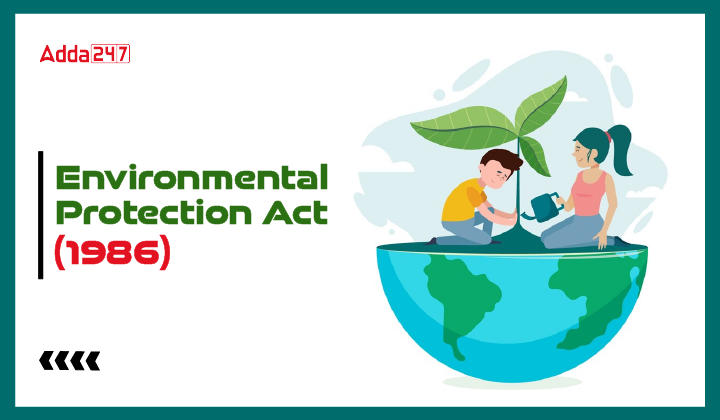Table of Contents
Environmental conservation has become a paramount concern in recent decades due to the alarming rate of degradation and its widespread impacts. In response to this pressing global issue, many countries have enacted legislation to safeguard and preserve the environment. Moreover, there has been a surge in grassroots movements and community-led initiatives aimed at fostering sustainable practices and raising awareness about the importance of protecting our planet.
In India, the Environmental Protection Act of 1986 stands as a landmark legal framework aimed at safeguarding the nation’s natural resources and promoting sustainable development. With its comprehensive framework and stringent regulations, this act has played a pivotal role in addressing environmental concerns and fostering a greener and healthier planet.
EPA 1986 History
The Environment (Protection) Act was made to help keep our environment safe and make it better. It gives the Central Government the power to create groups (explained in section 3(3)) responsible for stopping all kinds of pollution and dealing with environmental issues that are different in various parts of our country. The Act was changed the last time in 1991.”
- The 1980s witnessed a growing recognition of the detrimental impacts of human activities on the environment.
- In response to this global concern, the Environmental Protection Act of 1986 was enacted, signifying a significant step forward in environmental regulation.
- The act aimed to combat pollution, preserve natural resources, and ensure the well-being of both present and future generations.
Environmental Protection Act: Objectives
- The act encompasses a broad range of objectives, including the prevention and control of pollution, sustainable resource management, and the protection of ecosystems and biodiversity. It empowers regulatory authorities to enforce environmental standards and issue permits, encouraging compliance and accountability.
- One critical aspect of the act is the requirement for environmental impact assessments (EIAs) before commencing major projects. EIAs evaluate potential environmental risks and propose mitigation measures, integrating environmental considerations into decision-making processes and promoting sustainable development.
Provisions of the Environmental Protection Act 1986
The Environmental Protection Act of 1986, often referred to as the “EPA 1986,” is a significant piece of legislation in India that was enacted to provide the framework for environmental protection and conservation. The Act was passed in response to growing concerns about environmental degradation and the need to safeguard the environment and natural resources. Here are some key features and provisions of the Environmental Protection Act, 1986:
Environmental Impact Assessment (EIA)
The Act mandates the preparation of Environmental Impact Assessments (EIAs) for certain developmental projects to evaluate their potential environmental impact. This is crucial for sustainable development.
Regulatory Authorities
The EPA 1986 establishes regulatory authorities at the central and state levels to enforce environmental laws and regulations. The Central Pollution Control Board (CPCB) and State Pollution Control Boards (SPCBs) play key roles in this regard.
Pollution Control and Waste Management
- The act establishes robust regulations to address air and water pollution, as well as hazardous substances and waste management.
- It sets standards for the handling and disposal of hazardous materials, minimizing the risk of pollution and safeguarding human health.
- The act also encourages waste reduction, recycling, and resource recovery, promoting sustainable waste management practices.
Conservation of Natural Resources and Biodiversity
- Recognizing the importance of preserving natural resources and protecting biodiversity, the act provides provisions for the conservation of forests, wildlife, and natural habitats.
- It establishes protected areas and prohibits activities that could harm endangered species or their habitats.
- These measures ensure the sustainable management and protection of our natural heritage for future generations.
Challenges and Future Directions
- While the Environmental Protection Act 1986 has made significant strides in environmental protection, several challenges remain.
- These include ensuring effective implementation and enforcement of environmental regulations, addressing emerging issues such as climate change and plastic pollution, and fostering greater public participation in environmental decision-making processes.
- To address these challenges, continuous efforts are required to strengthen institutional capacities, enhance public awareness, and foster collaborations between various stakeholders, including the government, industries, civil society, and citizens.
Conclusion:
The Environmental Protection Act of 1986 has been instrumental in establishing a legal framework that promotes environmental protection, sustainable development, and public participation. By addressing pollution, waste management, and conservation, this act plays a vital role in safeguarding our planet for a sustainable future. It serves as a testament to our collective responsibility to nurture and protect the environment for generations to come.
Download UGC NET Study Notes Paper 1 PDF
The direct link to download UGC NET Study Notes Paper 1 PDF has been given below. Download Environmental Protection Act 1986 Study Notes here.




 UGC NET Commerce Syllabus 2025 PDF Downl...
UGC NET Commerce Syllabus 2025 PDF Downl...
 UGC NET Teaching Aptitude Questions Answ...
UGC NET Teaching Aptitude Questions Answ...
 UGC NET Philosophy Syllabus 2025 PDF Dow...
UGC NET Philosophy Syllabus 2025 PDF Dow...




